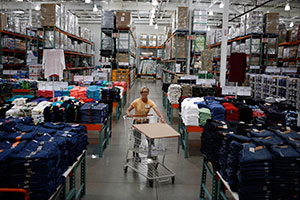Retail Sales Fall for Third Straight Month

Sales at U.S. retailers unexpectedly decreased in February for a third consecutive month as inclement weather and low wage gains restrained shoppers.
The 0.6% drop followed a 0.8% decrease in January, Commerce Department figures showed March 12 in Washington. The median forecast of 86 economists surveyed by Bloomberg News called for a 0.3% gain. Sales declined in nine of thirteen major categories, led by auto dealers and building supply merchants.
The coldest February on record in parts of the Northeast and Midwest, combined with sluggish pay increases, probably made Americans leery of spending the windfall from cheaper gasoline, using it instead to build up savings or pay down debt. At the same time, a strengthening job market and tame inflation will help sustain household purchases in coming months.
“Consumers aren’t really spending as much of their savings from lower gasoline prices as expected,” Tom Simons, an economist at Jefferies LLC in New York, said before the report. “It’s the bad weather, consumers not spending the fuel savings as much as expected, and subdued wage growth. But the labor market is doing pretty well.”
Estimates in the Bloomberg survey for total retail sales ranged from a decline of 0.2 percent to an advance of 0.7 percent. The January figure was previously reported as a drop of 0.8 percent.
Bad weather also probably a key issue in depressing sales last month. The eastern U.S. saw below-normal temperatures from Atlanta to New York and record snowfalls in New England. The National Oceanic and Atmospheric Administration’s data showed February was the snowiest month on record for Boston, while Chicago, Buffalo and Cleveland had their coldest February on record.
The hit from inclement weather was reflected in results at car companies. Ford Motor Co.’s light-vehicle sales slipped 2 percent while other top automakers reported smaller gains than analysts had estimated as the frigid temperatures slowed showroom traffic. The weakness isn’t too much of a concern, industry officials said.
“We go through this every year,” Erich Merkle, Ford’s sales analyst, said on a March 3 conference call with reporters and analysts. “It’s really hard to hang any hats at this point on January and February.”
The Commerce Department report showed sales declined 2.5 percent at automobile dealers, the most since January 2014, when snow also blanketed large swaths of the U.S.
Retail sales excluding autos decreased 0.1 percent, the report showed. They were projected to rise 0.5 percent, according to the Bloomberg survey median.
Receipts at service stations climbed 1.5 percent, the first increase since May 2014 and the biggest since December 2013, as fuel costs stabilized.
Regular gasoline at the pump cost $2.41 a gallon on the last day of February, according to AAA, the biggest U.S. motoring group. While the price has ticked up from a January average of $2.10, it remains well below last year’s high of $3.70.
Sales excluding automobiles and service stations decreased 0.2 percent, short of the projected gain of 0.3 percent in the Bloomberg survey.
The figures used to calculate gross domestic product, which exclude categories such as food services, auto dealers, home-improvement stores and service stations, showed little change in sales after a 0.1 percent drop in January.
The 2.3 percent drop in purchases at building-material stores was the biggest since May 2012.
One standout last month was non-store retailers, which includes online retailers. Purchases showed a 2.2 percent increase in demand, the largest since March 2014. That also points to a weather influence as Americans shopped from the warmth of their homes.
The labor market remains a source of strength for Americans. February marked the 12th straight month payrolls have increased by at least 200,000, the best run since a 19-month stretch that ended in March 1995.
Minneapolis-based Target Inc. is among retailers benefiting from rising household confidence and better sales helped by lower gasoline prices.
“The consumer, we do believe, is healthier, and we’re pleased that they are spending in our stores, both in our stores and online,” Chief Executive Officer Brian Cornell said in a Feb. 25 earnings call.
Household consumption, which accounts for almost 70 percent of the economy, is projected by economists to expand this quarter. It grew at a 4.2 percent annualized rate in the final quarter of 2014, the most since the last three months of 2010, according to revised figures from the Commerce Department.




